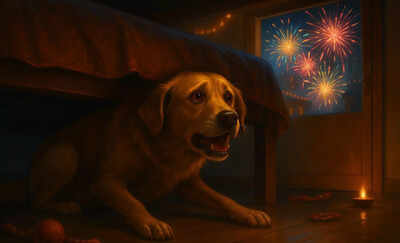Diwali is supposed to be a day of joy — a night when streets glow like rivers of gold, homes hum with laughter, and the sky blossoms with colour. But ask any dog parent, and they’ll tell you another story. They’ll describe the moment the first cracker goes off and their dog bolts under the bed, trembling. They’ll talk about the pacing, the panting, the desperate attempts to claw through a closed door. They’ll admit they dread the festival now — not because they hate celebration, but because they know what celebration does to their animals.For millions of dogs, Diwali is not a festival of light. It is a night of noise and terror, a prolonged panic attack that no amount of comforting words can soothe. What we call tradition, they experience as trauma. And the reason lies not in weakness or over-sensitivity, but in the very biology that humans helped shape — a physiology honed over millennia for survival, now caught in a storm it cannot understand.
The Ancestry in Their Ears
Dogs are not creatures of neon-lit cities and concrete courtyards. They are descendants of wolves — hunters, scavengers, and survivors whose lives depended on hearing the faintest crackle of danger long before it reached them. Over tens of thousands of years, humans domesticated them, but evolution left their senses largely untouched. A dog can hear frequencies up to 65,000 Hz, more than three times higher than a human ear. It’s a superpower when you need to track prey or sense distant footsteps. But it becomes a liability when surrounded by firecrackers designed to overwhelm even human ears.A single firecracker can exceed 150 decibels — louder than a jet engine. To us, it’s a loud pop; to them, it’s a physical blow. Their pinnae — the external parts of their ears — rotate independently, allowing them to locate the source of a sound almost instantly. In nature, that ability meant survival. During Diwali, it means they cannot not notice the barrage. Each explosion feels close, targeted, and inescapable. What we perceive as a nuisance, they process as a sensory emergency.
Fear Circuits Hijacked
The raw sound alone isn’t the problem. The real issue is how their brains interpret it. Deep within the canine brain sits the amygdala, a small structure tasked with one of evolution’s oldest jobs: recognising threats and triggering survival responses. Sudden, unpredictable noise has always meant danger — a predator breaking a branch, a tree cracking in a storm, thunder heralding danger from the skies. The amygdala doesn’t ask for context. It reacts.When a firecracker detonates, the amygdala does what it’s programmed to do: it floods the body with adrenaline and cortisol. The heart races, muscles tense, and the sympathetic nervous system kicks into overdrive. It’s the same fight-or-flight response that saved their wolf ancestors from predators — but here there’s nothing to fight and nowhere to flee. The physiological machinery spins out of control. Cortisol levels remain high for hours, sometimes days. Even when the last cracker has been lit, their bodies remain on high alert.
The Torture of Unpredictability
If fireworks followed a schedule — if they exploded every five minutes like clockwork — dogs might stand a chance at adapting. But they don’t. Their randomness is part of their appeal to us, and part of the terror for them. The brain’s fear circuits rely heavily on prediction. Once a stimulus becomes predictable, it loses its power. Fireworks are the opposite: a chaos of noise with no rhythm or warning. The body braces for the next blast but never knows when it will come.Humans can rationalise: It’s just Diwali, it will stop tomorrow. Dogs cannot. Their perception of time is tied to events, not calendars. They don’t know this noise has a name, a purpose, or an end. All they know is that the world has become loud, violent, and unpredictable — and it stays that way for hours.
A Symphony of Sensory Hell
The suffering is not limited to sound. Fireworks are a full-body event for dogs, each sensory input compounding the panic. Their paws and chests feel the deep, low-frequency vibrations — signals that in nature indicate an earthquake or a charging herd. Their noses, 100,000 times more sensitive than ours, are flooded with the acrid smell of sulphur and gunpowder — chemical signatures that mean fire or poison in the wild. Their eyes, evolved for tracking movement in dim light, are blinded and confused by sudden, bright flashes in the night. Even subtle shifts in air pressure from repeated explosions can unsettle the fluid balance of their inner ears, disorienting them further.This isn’t mere discomfort. It’s overload — a multi-sensory assault that the canine nervous system has no evolutionary defence against. Imagine being trapped in a room with deafening explosions, blinding strobe lights, a suffocating chemical stench, and the ground trembling beneath you. That’s Diwali for a dog.
The Memory of Fear
Once experienced, the fear doesn’t simply vanish. Dogs are masters of associative learning — the same mechanism that made Pavlov’s bell experiments possible. If a loud noise once triggered terror, the context around that noise becomes a trigger too. That’s why many dogs start trembling as dusk falls during Diwali week, even before the first firecracker ignites. Their nervous system remembers. This anticipatory anxiety is often worse than the event itself, and repeated trauma can hardwire it into their behaviour. Over time, many develop full-blown noise phobias — clinical conditions that extend beyond festival season, affecting their quality of life long after the diyas are extinguished.
Biology Against Culture
There is an irony to all this. Fireworks are meant to symbolise victory over darkness, joy over despair, light over ignorance. Yet, for the animals that share our homes and streets, they represent the opposite: chaos over calm, panic over peace, fear over trust. Dogs, after all, are a biological story written alongside ours. We shaped them over millennia to be attuned to our lives, our moods, our movements. And then, on the one night we claim to celebrate compassion and light, we subject them to a terror they cannot comprehend.The contradiction is striking. We call dogs “family,” and then insist they should “get used to it.” But neuroscience disagrees. Most dogs don’t habituate to fireworks — they sensitise. Repeated exposure intensifies the fear instead of dulling it. Studies show that many dogs become more reactive with each passing year, not less. The result is a tragic cycle: humans normalise the noise, and dogs pay the biological price.




